55 Gallon Aquascape Ideas
Posted by on 02/25/2023
We use affiliate links and may receive a small commission on purchases.
55 Gallon Aquariums are not only impressive to look at, but they also allow hobbyists to create tons of interesting aquascapes. As long as you have the proper equipment, the sky's the limit when it comes to hardscape and plant options.
If you're looking for some design inspiration, you're in luck, because in this post, we're going to suggest 5 planted tank designs that you can recreate or use for inspiration in your 55-gallon tank.
January's Giveaways on Light Fish
Benefits of Owning a 55-Gallon Tank
Not only is a 55-gallon tank impressive to look at, but there are also some benefits to owning a larger aquarium that beginner hobbyists may not be aware of. One of those benefits is water chemistry stability. Compared to nano aquariums, a 55-gallon tank will experience fewer sudden swings in water chemistry, giving you more time to correct a problem before it has serious consequences for your tank inhabitants.
You'll also need to trim your aquatic plants less frequently, which reduces your weekly and monthly maintenance routine.
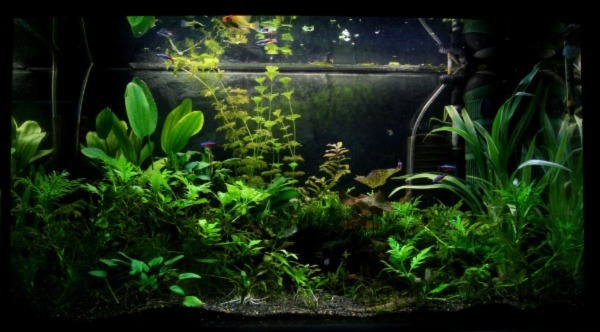
55 Gallon Aquascape Ideas
Incorporating plants of varying sizes is easily achievable in a 55-gallon tank, which provides ample space. While large aquatic plants can cause overcrowding in a small aquarium, they fit naturally in a larger tank.
Plus, having the extra room will allow you to add different types of stone and driftwood which gives your tank a more authentic aesthetic.
Jungle Style
High plant density and overgrowth are the key ingredients to recreating a jungle-style aquascape. Hobbyists looking to mimic this aquascape should plant heavily from the start, and allow for quite a few months of growth before trying to nail an award-winning photo.
One of the nice parts about owning a Jungle-inspired aquascape is that you can incorporate many different types of plants, which you can then trade to other hobbyists.
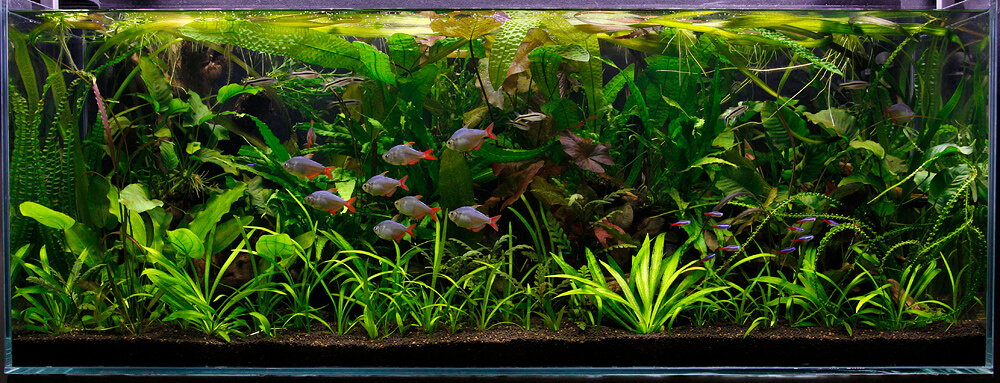
Hardscape
Large pieces of driftwood are often used in jungle aquascapes. Not only is driftwood pleasing to look at, but it can also provide more surface area for algae and mosses to grow on.
Spider Wood
Known for its twisted shapes and resemblance to a tree root, Spiderwood fits naturally in a jungle-inspired aquascape. The wood features plenty of extensions, which will give you plenty of surface area to tie rhizome-based plants, such as anubias.
Plant Options
Aim for dark and wide-leaved plants to create a lot of shadow in the tank. While there are plenty of plants you can use, here are a few options to get you started.
Anubias
Easy to grow, and easy to care for, Anubias plants can be used as foreground and midground plants in a jungle aquascape.
Plant Highlights:
Care: Easy
Growth rate: Slow to moderate
Light: Low
pH: 6-7.5
Height: 2-3"
CO2: Not required
Propagation: Separate by rhizome
🛒 Shop Freshwater Fish on Light Fish
Taiwan Lilies
Nymphoides Hydrophylla, more commonly known as Taiwan Lilies, are known for their wide leaves which resemble the water lily .
In a jungle aquascape, the plant will grow toward the light fixture, eventually blocking the light resulting in a dimly lit substrate.
Plant Highlights:
Care: Easy
Growth rate: Medium
Light: Moderate
Height: 4-6"
pH: 6-7.5
CO2: Not required
Propagation: Leaves will naturally sprout roots
Amazon Sword
Amazon Swords are large plants, making them the perfect choice for a 55-gallon jungle aquascape. Their large height makes them an ideal background plant. Best of all, their narrow leaves will provide plenty of coverage for Neocaridina shrimp, such as the orange pumpkin and blue dream color morphs.
Plant Highlights:
Care: Easy
Growth rate: Fast
Light: Moderate
Height: 4-20"
pH: 6-7.5
CO2: Not required
Propagation: Side shoots
Dragon Stone and Driftwood
Dragon stone, also referred to as Ohko stone, is one of the most popular stones in the planted tank scene. Named after its scale-like texture, its brown coloration pairs beautifully with driftwood and the green coloration of most aquatic plants.
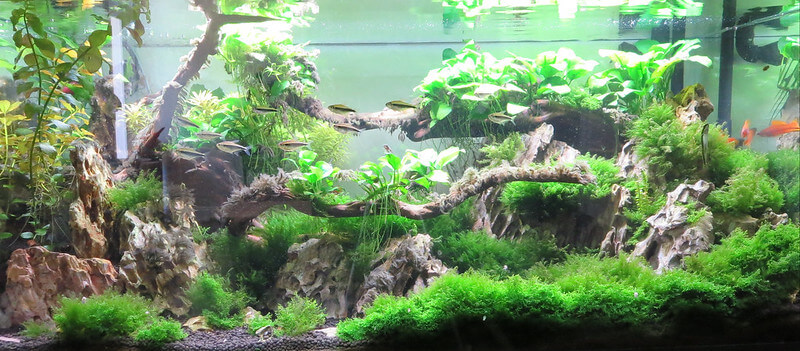
Hardscape
You'll want to provide plenty of different types of stones that have a scaly, craggy texture, as well as large pieces of wood.
Avoid smooth stones, as these tend to look a bit better in more minimalist cichlid aquascapes.
Dragon Stones
Dragon stones are an essential part of this aquascape. Aim for at least 10 lbs of rock if you plan on combining it with another type of stone, such as Seiryu.
If dragon stones will be the only type of stone featured in the scape, aim for at least 20 lbs.
Seiryu Stones
Although we see these stones used more frequently in Iwagumi aquascapes, Seiryu stones can be used in combination with Dragon stones to add gray coloration to your hardscape.
Aim for at least 10 lbs of Seiryu stones if you plan on combining them with existing dragon stones.
Malaysian Driftwood
We recommend going with Malaysian driftwood in this aquascape. This dark-colored wood goes nicely with the deep greens and shadows cast by many of the plants incorporated into the tank build.
Plant Options
Plenty of aquarium plants should be incorporated into this aquascape. The lush foliage will contrast nicely with the grays and browns seen from the dragon stone and driftwood.
While virtually any green-colored aquatic plant will work well, here are some options to get you started.
Anubias Nana Petite
Similar to anubias, anubias nana petite is an almost-identical looking species, but with a much smaller size.
This plant will only grow to about 5 inches in height, making it a great choice to attach to your driftwood with fishing line .
Plant Highlights:
Care: Easy
Growth rate: Slow to moderate
Light: Low
Height: 3-5"
pH: 6-7.5
CO2: Not required
Propagation: Separate by rhizome
🛒 Shop Aquarium Plants Fish on Light Fish
Java Fern
Java Fern is a rhizome-based plant, and similar to Anubias Nana Petite, can be attached via a fishing line to your aquarium hardscape. It's one of the first plants recommended to beginners, but that doesn't mean it doesn't deserve a spot in an award-winning aquascape.
Be warned though, if some of the leaves start to turn brown, they'll eventually die off. Since this plant is slow growing, you'll need to maintain a healthy level of nutrients for as long as you plan on keeping this plant around.
Plant Highlights:
Care: Easy
Growth rate: Slow to moderate
Light: Low
Height: 3-12"
pH: 6-7.5
CO2: Not required
Propagation: Separate by rhizome
Flame Moss
Flame Moss is similar to the more common Java Moss, except that the plant grows vertically rather than horizontally. It's easy to care for and looks spectacular as a foreground plant in a foliage-rich aquascape.
Plant Highlights:
Care: Easy
Growth rate: Slow
Light: Low to Medium
Height: 1-2"
pH: 6-8
CO2: Recommended
Propagation: Trim
Biotope
Biotope aquariums are recreations of natural environments. For example, a Biotope that resembles the Orinoco river may feature cardinal tetras and green phantom plecos, and plant species from the Cabomba and Alternanthera genera. All of which can be found in this location in nature.
While these tanks may not be as dazzling as dutch style or iwagumi tanks, recreating a natural environment in a home aquarium is an impressive accomplishment.
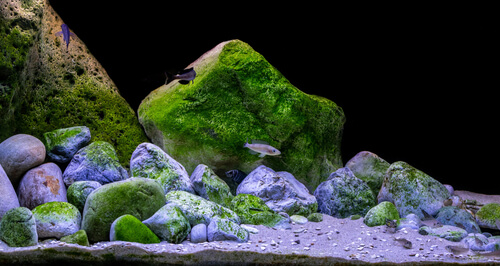
Hardscape Options
You'll want to determine what hardscape is present in the environment you wish to recreate. In most cases, you'll want to look for natural pieces of wood, smooth stones, and a gravel substrate.
Oak
You'll need to hunt down which types of wood are available in the region you're recreating, but in most cases weathered Oak branches work well for many biotopes.
This dark brown wood should have some bumps and ridges to it to give the biotope a natural look.
Brown Leaves
Many natural habitats will have decomposing leaves, so you'll want to locate which trees might be present in the region you're recreating.
Birch, chestnut, and maple leaves tend to be the most common, and they can occasionally be found for sale on our marketplace.
Plants
The plants you choose for a biotope will largely depend on the region you're trying to recreate. If recreating the Orinoco river interests you, you can't go wrong with Cabomba, Salivina, Riccia, Bacopa, and Vallisneria plant species, all of which exist in this environment.
Dutch Style
Arguably the most popular aquascaping style, Dutch-style tanks are known for their high plant density, which often incorporates red-colored plants to draw the eye to one particular area of the tank.
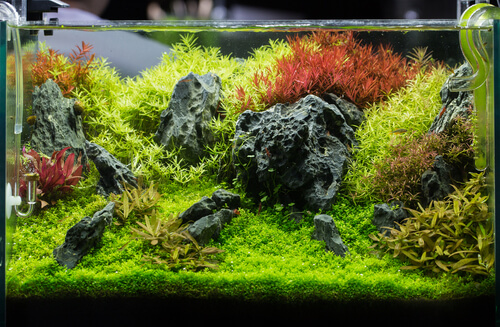
Dutch-style aquariums do not use any hardscape, so you'll want to experiment with plenty of different types of plants.
Plants
You'll want strong lighting and CO2 injection via a reactor or diffuser to grow some of the more advanced plants seen in these aquascapes.
Virtually any plant is fair game for a dutch style aquascape, but you'll want to have a nice variety of foreground plants, midground plants, and background plants.
Red aquatic plants are essential, as they'll contrast beautifully with the wide variety of green-colored plants seen in these scapes.
Iwagumi Style
Another popular style is the Iwagumi aquascape. Created by the famous aquarist Takashi Amano , these tanks feature minimalist designs, typically using one foreground plant and Seiryu stones.
These tanks are impressive to look at, but you'll need to perform frequent water changes and pay close attention to your light intensity, or else you'll run into algae problems.
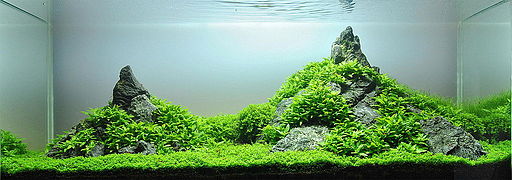
Hardscape (Seiryu stones)
In Iwagumi aquascapes, typically only one type of craggy-looking stone is used. The iconic stone for this aquascape is the Seiryu stone, but we've seen some creative alternatives that incorporate different types of stone.
Aim for at least 20 lbs of Seiryu stones for an Iwagumi aquascape in a 55-gallon tank.
Plants
In a traditional Iwagumi scape, typically only one foreground plant is used. Luckily for aquarists, there are a ton of interesting foreground plant options, each with different lighting and care requirements.
While virtually any foreground plant will do, here are a few great choices.
Hemianthus callitrichoides
Often abbreviated as "HC", or "Dwarf Baby Tears", Hemianthus callitrichoides is the most common foreground plant seen in Iwagumi aquascapes.
It's one of the brightest foreground plants in the hobby, but it can be challenging to grow. High light and CO2 injection are a must, and this plant does tend to uproot itself after a while. Make sure you are up for the challenge of maintaining this plant before deciding on it for your Iwagumi aquascape.
Plant Highlights:
Care: Medium to Difficult
Growth rate: Moderate to Fast
Light: Medium to High
Height: 1-2"
pH: 6-7.5
CO2: Required
Propagation: Cut vertically and re-plant
Dwarf Hairgrass
If you want to grow a grass-like carpet, look no further than Dwarf Hairgrass. Once this plant settles into a tank, it grows quickly, and maintenance is a breeze as it anchors deep into the substrate, and rarely uproots during trimmings.
Plant Highlights:
Care: Easy
Growth rate: Moderate to Fast
Light: Low to High
Height: 1-2"
pH: 6-7.5
CO2: Recommended
Propagation: Cut vertically and re-plant
Staurogyne repens
Known for being easy to keep and grow, Staurogyne repens, often abbreviated as "S Repens", is a beautiful foreground plant that looks fantastic in an Iwagumi aquascape. Give this plant some time to settle into its new environment before looking for signs of growth.
After a few months of regular trimmings, this plant can easily carpet a 55-gallon tank, and won't grow tall enough to make your aquarium look uncared for.
Plant Highlights:
Care: Easy to Medium
Growth rate: Moderate to Fast
Light: Medium to High
Height: 1-3"
pH: 6-7.5
CO2: Required
Propagation: Cut stem and replant
Conclusion
As you can see, a 55-gallon aquarium is a perfect size to build all sorts of different aquascapes. Combining a large tank with a reliable CO2 system and light fixture, and virtually any aquascape is achievable.
Now that we've recommended a few options, do you think you have what it takes to build an award-winning or Instagram-worthy aquascape? Let us know by commenting below, or by sharing pictures of your tank on our community forum.
Oh, and if you have some extra plants to sell, be sure to check out our marketplace, where you can trade with other hobbyists. Happy aquascaping!
January's Giveaways on Light Fish














